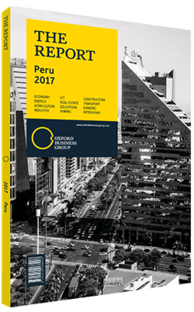Government bonds
With a rating of “BBB+/A3”, Peru has solid economic fundamentals to support its bond market. The country is a leader in terms of economic growth in South America, has strong macroeconomic balances, low public debt, a robust financial system, low country risk metrics and a broad portfolio of infrastructure projects.
Emerging Appetite
Despite the recent downward trend in GDP, the bond market has benefitted from the increased appetite of investors for emerging markets. Institutions such as the World Bank and Moody’s credit ratings agency have highlighted a change in direction of investment flows in international fixed-income markets. Investors have been exiting world markets that appreciated significantly in 2016, including Europe and Asia, and have been turning to emerging economies, attracted by interest rate spreads, the recovery of base metal prices and the change in the economic cycle in certain countries in Latin America, led by Brazil.
The yield curve in the soles sovereign bond market appreciated by 58 basis points on average during the first quarter of 2017. The consequent inflow of US dollars forced the central bank to acquire just over $1bn in the foreign exchange market to slow down the appreciation of the sol. The total Peruvian bond market, public and private, grew by 11.1% per annum over the last decade, and has gone from representing 19% of GDP in 2006 to 24.7% in 2016. The total outstanding is close to $50.2bn, of which 65% corresponds to public sector bonds and 35% to the private sector.
Public Bonds
Peru has a structural advantage in its low level of public debt, which is 23.8% of GDP, compared to an average of 108.6% in advanced economies and 47.3% in emerging economies. This is thanks to government access and flexibility to new financing, and restructuring of the country’s existing debt, extending its duration and taking advantage of better interest rates. In accordance with its strategy of global management of assets and liabilities, the Peruvian government has encouraged the placement of sovereign bonds, denominated in soles, the outstanding volume of which increased at an annual rate of 17.8% during the last decade. Meanwhile, global Peru bonds, denominated mostly in US dollars, increased by only 3.3% per annum. This strategy of issuing sol-denominated sovereign bonds over global bonds has reduced the exchange rate risk and interest rate risk in a context of rising interest rates on US-dollar denominated assets as the US Federal Reserve continues its process of monetary policy normalisation. Peru last issued on international markets in the first quarter of 2016, placing $1.15bn in global bonds. This was used to pre-finance the fiscal resources needed for 2017 and was timed to take advantage of low international interest rates at the moment. Peru’s public debt management has been well recognised by market sources.
The higher yields in soles, 5.6% on average, compared to the US bond curve of 1.9%, in a context of inflation anchored at 3% and an appreciating sol, have been a strong draw for foreign investors. In addition, the government introduced changes to trading in sovereign bonds, which may now be liquidated abroad, enhancing their accessibility to foreign investment funds. Holdings of sovereign bonds by non-residents increased from 35.4% to 37.1% in the year to February 2017.
Private Bond Market
The local private bond market grew by 4.6% per year over the last 10 years. However, it is now a larger market, representing 3.5% of GDP. The market is dominated by short- and medium-term issuances, with tickets that do not normally exceed $500m. Bank placements predominate, accounting for 92% of private bonds issued domestically in the first quarter of 2017. The current low level of corporate issuance correlates with slow private investment. For larger tickets, many companies issue on world markets. Looking forward, the bond market should benefit as infrastructure investment is allocated. Peru has a portfolio of projects that have already been tendered, albeit with some postponements, equivalent to 9% of GDP.
You have reached the limit of premium articles you can view for free.
Choose from the options below to purchase print or digital editions of our Reports. You can also purchase a website subscription giving you unlimited access to all of our Reports online for 12 months.
If you have already purchased this Report or have a website subscription, please login to continue.

